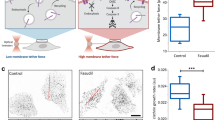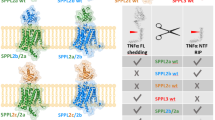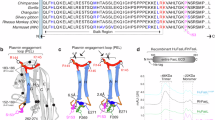Abstract
Fas ligand (FasL) is a type II transmembrane protein belonging to the tumor necrosis factor family. Its binding to the cognate Fas receptor triggers the apoptosis that plays a pivotal role in the maintenance of immune system homeostasis. The cell death-inducing property of FasL has been associated with its extracellular domain, which can be cleaved off by metalloprotease activity to produce soluble FasL. The fate of the remaining membrane-anchored N-terminal part of the FasL molecule has not been determined. Here we show that post-translational processing of overexpressed and endogenous FasL in T-cells by the disintegrin and metalloprotease ADAM10 generates a 17-kDa N-terminal fragment, which lacks the receptor-binding extracellular domain. This FasL remnant is membrane anchored and further processed by SPPL2a, a member of the signal peptide peptidase-like family of intramembrane-cleaving proteases. SPPL2a cleavage liberates a smaller and highly unstable fragment mainly containing the intracellular FasL domain (FasL ICD). We show that this fragment translocates to the nucleus and is capable of inhibiting gene transcription. With ADAM10 and SPPL2a we have identified two proteases implicated in FasL processing and release of the FasL ICD, which has been shown to be important for retrograde FasL signaling.
Similar content being viewed by others
Log in or create a free account to read this content
Gain free access to this article, as well as selected content from this journal and more on nature.com
or
Abbreviations
- FasL:
-
Fas ligand
- sFasL:
-
soluble Fas ligand
- APL:
-
ADAM10-processed FasL form
- SPA:
-
SPPL2a-processed APL
- (N)ICD:
-
(Notch) intracellular domain
- PS:
-
presenilins
- MMP:
-
matrix metalloprotease
- TACE:
-
tumor necrosis factor-alpha (TNF-α)-converting enzyme
- ADAM:
-
a disintegrin and metalloproteinase
- SPPL:
-
signal peptide peptidase-like
- RIP:
-
regulated intramembrane proteolysis
- I-CliP:
-
intramembrane-cleaving protease
- kDa:
-
kilo Dalton
- CKI:
-
casein kinase I
- FCH domain:
-
Fes/CIP4 homology domain
- SH3 domain:
-
Src homology 3 domain
- NCoR:
-
nuclear receptor coreppressor
- NLS:
-
nuclear localization signal
- PHA:
-
phytohemagglutinin
- DMEM:
-
Dulbecco's Modified Eaglés Medium
- HEK293 cells:
-
human embryonic kidney 293 cells
- ATCC:
-
American Type Culture Collection
- SDS-PAGE:
-
sodium dodecyl sulfate-polyacrylamide gel electrophoresis
- PVDF:
-
polyvinyliden difluoride
References
Janssen O, Qian J, Linkermann A, Kabelitz D . CD95 ligand – death factor and costimulatory molecule? Cell Death Differ 2003; 10: 1215–1225.
Li-Weber M, Krammer PH . Function and regulation of the CD95 (APO-1/Fas) ligand in the immune system. Semin Immunol 2003; 15: 145–157.
Kavurma MM, Khachigian LM . Signaling and transcriptional control of Fas ligand gene expression. Cell Death Differ 2003; 10: 36–44.
Martinez-Lorenzo MJ, Anel A, Gamen S, Monle n I, Lasierra P, Larrad L et al. Activated human T cells release bioactive Fas ligand and APO2 ligand in microvesicles. J Immunol 1999; 163: 1274–1281.
Bohana-Kashtan O, Civin CI . Profiling tumor counterattack: do Fas ligand-containing microvesicles reduce anticancer immunity? Clin Cancer Res 2005; 11: 968–970.
Dhein J, Walczak H, Baumler C, Debatin KM, Krammer PH . Autocrine T-cell suicide mediated by APO-1/(Fas/CD95). Nature 1995; 373: 438–441.
Tanaka M, Suda T, Takahashi T, Nagata S . Expression of the functional soluble form of human fas ligand in activated lymphocytes. EMBO J 1995; 14: 1129–1135.
Knox PG, Milner AE, Green NK, Eliopoulos AG, Young LS . Inhibition of metalloproteinase cleavage enhances the cytotoxicity of Fas ligand. J Immunol 2003; 170: 677–685.
Schneider P, Holler N, Bodmer JL, Hahne M, Frei K, Fontana A et al. Conversion of membrane-bound Fas(CD95) ligand to its soluble form is associated with downregulation of its proapoptotic activity and loss of liver toxicity. J Exp Med 1998; 187: 1205–1213.
Desbarats J, Duke RC, Newell MK . Newly discovered role for Fas ligand in the cell-cycle arrest of CD4+ T cells. Nat Med 1998; 4: 1377–1382.
Sun M, Ames KT, Suzuki I, Fink PJ . The cytoplasmic domain of Fas ligand costimulates TCR signals. J Immunol 2006; 177: 1481–1491.
Suzuki I, Fink PJ . Maximal proliferation of cytotoxic T lymphocytes requires reverse signaling through Fas ligand. J Exp Med 1998; 187: 123–128.
Suzuki I, Martin S, Boursalian TE, Beers C, Fink PJ . Fas ligand costimulates the in vivo proliferation of CD8+ T cells. J Immunol 2000; 165: 5537–5543.
Baum W, Kirkin V, Fernandez SB, Pick R, Lettau M, Janssen O et al. Binding of the intracellular Fas ligand (FasL) domain to the adaptor protein PSTPIP results in a cytoplasmic localization of FasL. J Biol Chem 2005; 280: 40012–40024.
Qian J, Chen W, Lettau M, Podda G, Zornig M, Kabelitz D et al. Regulation of FasL expression: a SH3 domain containing protein family involved in the lysosomal association of FasL. Cell Signal 2006; 18: 1327–1337.
White JM . ADAMs: modulators of cell–cell and cell–matrix interactions. Curr Opin Cell Biol 2003; 15: 598–606.
Friedmann E, Lemberg MK, Weihofen A, Dev KK, Dengler U, Rovelli G et al. Consensus analysis of signal peptide peptidase and homologous human aspartic proteases reveals opposite topology of catalytic domains compared with presenilins. J Biol Chem 2004; 279: 50790–50798.
Schneider P, Bodmer JL, Holler N, Mattmann C, Scuderi P, Terskikh A et al. Characterization of Fas (Apo-1, CD95)-Fas ligand interaction. J Biol Chem 1997; 272: 18827–18833.
Eischen CM, Williams BL, Zhang W, Samelson LE, Lynch DH, Abraham RT et al. ZAP-70 tyrosine kinase is required for the up-regulation of Fas ligand in activation-induced T cell apoptosis. J Immunol 1997; 159: 1135–1139.
Vargo-Gogola T, Crawford HC, Fingleton B, Matrisian LM . Identification of novel matrix metalloproteinase-7 (matrilysin) cleavage sites in murine and human Fas ligand. Arch Biochem Biophys 2002; 408: 155–161.
Zheng Y, Saftig P, Hartmann D, Blobel C . Evaluation of the contribution of different ADAMs to tumor necrosis factor alpha (TNFalpha) shedding and of the function of the TNFalpha ectodomain in ensuring selective stimulated shedding by the TNFalpha convertase (TACE/ADAM17). J Biol Chem 2004; 279: 42898–42906.
Hundhausen C, Misztela D, Berkhout TA, Broadway N, Saftig P, Reiss K et al. The disintegrin-like metalloproteinase ADAM10 is involved in constitutive cleavage of CX3CL1 (fractalkine) and regulates CX3CL1-mediated cell–cell adhesion. Blood 2003; 102: 1186–1195.
Zhou BB, Peyton M, He B, Liu C, Girard L, Caudler E et al. Targeting ADAM-mediated ligand cleavage to inhibit HER3 and EGFR pathways in non-small cell lung cancer. Cancer Cell 2006; 10: 39–50.
Fortini ME . Gamma-secretase-mediated proteolysis in cell-surface-receptor signalling. Nat Rev Mol Cell Biol 2002; 3: 673–684.
Martinez Arias A, Zecchini V, Brennan K . CSL-independent Notch signalling: a checkpoint in cell fate decisions during development? Curr Opin Genet Dev 2002; 12: 524–533.
Weihofen A, Martoglio B . Intramembrane-cleaving proteases: controlled liberation of proteins and bioactive peptides. Trends Cell Biol 2003; 13: 71–78.
Weihofen A, Lemberg MK, Ploegh HL, Bogyo M, Martoglio B . Release of signal peptide fragments into the cytosol requires cleavage in the transmembrane region by a protease activity that is specifically blocked by a novel cysteine protease inhibitor. J Biol Chem 2000; 275: 30951–30956.
Cowan JW, Wang X, Guan R, He K, Jiang J, Baumann G et al. Growth hormone receptor is a target for presenilin-dependent gamma-secretase cleavage. J Biol Chem 2005; 280: 19331–19342.
Gupta-Rossi N, Le Bail O, Gonen H, Brou C, Logeat F, Six E et al. Functional interaction between SEL-10, an F-box protein, and the nuclear form of activated Notch1 receptor. J Biol Chem 2001; 276: 34371–34378.
Kimberly WT, Zheng JB, Guenette SY, Selkoe DJ . The intracellular domain of the beta-amyloid precursor protein is stabilized by Fe65 and translocates to the nucleus in a notch-like manner. J Biol Chem 2001; 276: 40288–40292.
Carpenter G . Nuclear localization and possible functions of receptor tyrosine kinases. Curr Opin Cell Biol 2003; 15: 143–148.
Tagami T, Madison LD, Nagaya T, Jameson JL . Nuclear receptor corepressors activate rather than suppress basal transcription of genes that are negatively regulated by thyroid hormone. Mol Cell Biol 1997; 17: 2642–2648.
Fas SC, Fritzsching B, Suri-Payer E, Krammer PH . Death receptor signaling and its function in the immune system. Curr Dir Autoimmun 2006; 9: 1–17.
Reiss K, Maretzky T, Haas IG, Schulte M, Ludwig A, Frank M et al. Regulated ADAM10-dependent ectodomain shedding of gamma-protocadherin C3 modulates cell–cell adhesion. J Biol Chem 2006; 281: 21735–21744.
Martoglio B, Golde TE . Intramembrane-cleaving aspartic proteases and disease: presenilins, signal peptide peptidase and their homologs. Hum Mol Genet 2003; 12 (Spec No 2): R201–R206.
Fluhrer R, Grammer G, Israel L, Condron MM, Haffner C, Friedmann E et al. A gamma-secretase-like intramembrane cleavage of TNFalpha by the GxGD aspartyl protease SPPL2b. Nat Cell Biol 2006; 8: 894–896.
Friedmann E, Hauben E, Maylandt K, Schleeger S, Vreugde S, Lichtenthaler SF et al. SPPL2a and SPPL2b promote intramembrane proteolysis of TNFalpha in activated dendritic cells to trigger IL-12 production. Nat Cell Biol 2006; 8: 843–848.
Miele L, Miao H, Nickoloff BJ . NOTCH signaling as a novel cancer therapeutic target. Curr Cancer Drug Targets 2006; 6: 313–323.
Acknowledgements
We thank S Bösser for excellent technical assistance, and P Scherle (Incyte Corporation, Wilmington, Delaware, USA) for providing the small molecule inhibitors INCB-3619, INCB-3420, INCB-8765 and INCB-12881. This work was supported in part by grants from the DFG (ZO 110/2; MZ), the German National Genome Research Network (NGFN project N1KR-S12T23; VK and MZ), the Centre National de la Recherche Scientifique (AOH), the Ligue Nationale contre le Cancer (AOH), the Association pour la Recherche contre le Cancer (AOH), The Emerald Foundation (AOH) and the Canceropole-PACA ACI 2004 (AOH).
Author information
Authors and Affiliations
Corresponding authors
Additional information
Edited by PH Krammer
Supplementary Information accompanies the paper on Cell Death and Differentiation website (http://www.nature.com/cdd)
Supplementary information
Rights and permissions
About this article
Cite this article
Kirkin, V., Cahuzac, N., Guardiola-Serrano, F. et al. The Fas ligand intracellular domain is released by ADAM10 and SPPL2a cleavage in T-cells. Cell Death Differ 14, 1678–1687 (2007). https://doi.org/10.1038/sj.cdd.4402175
Received:
Revised:
Accepted:
Published:
Issue date:
DOI: https://doi.org/10.1038/sj.cdd.4402175
Keywords
This article is cited by
-
Interplay between soluble CD74 and macrophage-migration inhibitory factor drives tumor growth and influences patient survival in melanoma
Cell Death & Disease (2022)
-
Inhibition of mitochondrial complex II in neuronal cells triggers unique pathways culminating in autophagy with implications for neurodegeneration
Scientific Reports (2021)
-
Physiological functions of SPP/SPPL intramembrane proteases
Cellular and Molecular Life Sciences (2020)
-
Impairment of Fas-ligand–caveolin-1 interaction inhibits Fas-ligand translocation to rafts and Fas-ligand-induced cell death
Cell Death & Disease (2018)
-
Disruption of an antimycobacterial circuit between dendritic and helper T cells in human SPPL2a deficiency
Nature Immunology (2018)



